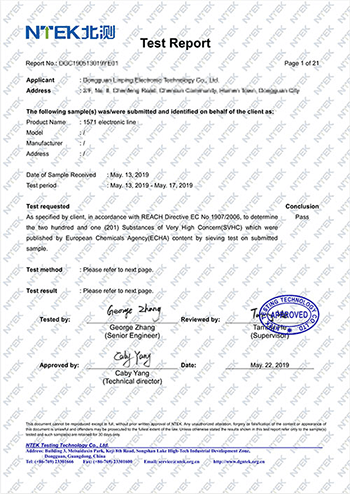EU REACH Introduction
The full name of REACH is "Registration, Evaluation, Authorization and Restriction of Chemicals", that is, European Union Regulation (EC) No 1907/2006. . The purpose is to ensure a high level of protection of human health and the environment, promote the free circulation of chemicals on the EU market, and improve competitiveness and innovation.
SVHC Checklist Update
September 3, 2019: The European Chemicals Agency (ECHA) conducts a public consultation on the four substances proposed to be added to the SVHC list. The substance names are as follows:
2-benzyl-2-dimethylamino-1- (4-morpholinyl) butanone
2-methyl-1- (4-methylthiophenyl) -2-morpholinyl-1-acetone
Diisohexyl phthalate
Perfluorobutylsulfonic acid (PFBS) and its salts
July 16, 2019: The European Chemical Agency (ECHA) updated the SVHC list with the latest required items of 201 items.
Applicable product range
The scope of the REACH regulation is broad. It covers almost all non-food, feed and pharmaceutical commercial products. Consumer products such as clothing and footwear, jewelry, electrical and electronic products, toys, furniture, and health and beauty products are all covered by the REACH regulation.
Regulation content
registered
For any chemical reaching the threshold of one ton per year, manufacturers and importers must apply for registration, whether the chemical itself exists as a chemical substance, or as part of a mixture, or as a substance or mixture released from an article. Since only individuals in the EU or companies established in the EU can submit REACH registrations, non-EU companies that need to register a chemical substance need to appoint the sole representative (OR) to perform it. The European Chemicals Agency (ECHA) evaluates the information submitted by the registration.
limit
Each restricted substance has different conditions and restricted ranges. For example, a harmful substance itself may be prohibited from being placed on the EU market, or products containing a certain concentration of the substance may be prohibited. Appendix XVII is the list of restricted substances, which is updated regularly.
Authorization
The purpose of authorization is to eliminate or effectively control the risks posed by chemicals, especially those that are harmful to human health or the environment. This process is divided into two main phases, each of which requires certain stakeholders in the supply chain to assume certain obligations:
A substance has been identified as a Substance of Very High Concern (SVHC) and has been placed on the candidate list. If the content of an SVHC exceeds 0.1% by weight, the information is immediately transmitted to the recipient of the item in the supply chain. Consumers can also request this information from retailers, and this information must be provided within 45 days. If the weight of SVHC in the article exceeds 0.1% and exceeds 1 ton per year, ECHA must be notified. The candidate list is updated twice a year.
Substances listed on the candidate list will be prioritized for authorization list (Appendix XIV). Unless authorized, SVHC on the authorized list cannot be used or imported into the EU after a specified date (known as the sunset date). Authorization applies only to chemicals used in and / or imported into the EU, and articles manufactured in the EU. However, it does not apply to items imported from the European Union. The authorization list is updated approximately every year.
All products manufactured in or imported into the EU must comply with all applicable REACH requirements. It is important to remember that meeting one requirement does not mean that other requirements can be waived. For example, in addition to meeting the requirements related to the candidate list, a product may also need to meet certain restrictions.
Certificate information
 Hot Line
400-800-6106
Hot Line
400-800-6106
